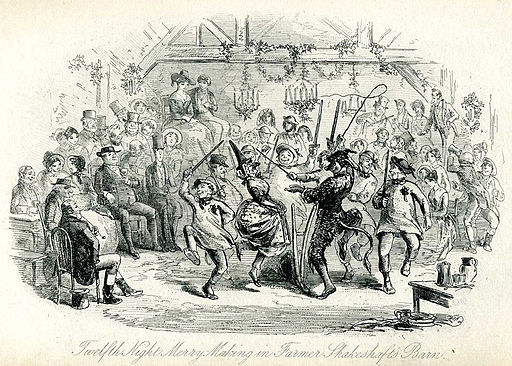by Maria Grace
Each year it seems we complain that the holiday season begins earlier and earlier with some shops bringing out holiday goods even in the last months of summer. The holiday calendar during the Regency era was a little more clearly defined, with a very predictable set of dates and events for celebration. Holiday celebrations and traditions extended from a week before Advent all the way through to Twelfth Night in January. During the entire season people held a wide variety of festivities including balls, parties, dinners, house parties and visits, skating and card parties as well as smaller gatherings and even weddings.
Stir it up Sunday
 |
| Flaming Christmas Pudding |
Christmas pudding was prepared with 13 ingredients to represent Christ and the 12 apostles with all family members who must take a hand in the stirring using a special wooden spoon (in honor of Christ's crib and stable). The stirring must be done clockwise, from east to west to honor the journey of the Magi, with eyes shut, while making a secret wish. After the family stirred the pudding, tiny charms might be added to the pudding to reveal their finders’ fortune.
December 6th : St. Nicholas Day
In a tradition from Northern Europe, the day might be celebrated with the exchanging of small gifts particularly for children. Not everyone participated in this tradition.
December 21st: St. Thomas Day
St Thomas’ Day was a day for elderly women (often widows) to go ‘a'thomasing’ at the houses of their more fortunate neighbors hoping for gifts of food or money. Often times wheat was cooked and distributed to the ‘mumpers’ who came begging.
The wheat was an especially appreciated gift because the price of the commodity was very high. This practice had become especially common during the early 1800’s. The Napoleonic wars may have contributed to the practice by dramatically increasing the number of widows.
December 24th: Christmas Eve
 |
| Christmas Rose |
December 25th: Christmas day
Christmas Day usually began with a trip to church. Though gifts were not typically exchanged on this day, small gifts might be given to children. Cottagers would sometimes gave generous landowners a symbolic gift for Christmas Day as well.
Christmas Dinner was a feast to be anticipated. It often opened with a toast that included the servants who received their Christmas gifts at this time.
Boar’s head, roasted or brawn—a kind of potted meat dish—often took center stage. Roast goose, which might have to be cooked by a baker with a large oven and picked up on the way home from church, was another Christmas dinner favorite.
 Many also considered mince meat pies, also known as Christmas or Twelfth Night pies, staples for a Christmas feast. The pies contained chopped meat, dried fruit, spices and sugar. Leftovers from the Christmas feast would be used to make pies for the twelve days until Epiphany. Eating minced pie every day of the twelve days of Christmas was said to bring twelve months of happiness in the new year.
Many also considered mince meat pies, also known as Christmas or Twelfth Night pies, staples for a Christmas feast. The pies contained chopped meat, dried fruit, spices and sugar. Leftovers from the Christmas feast would be used to make pies for the twelve days until Epiphany. Eating minced pie every day of the twelve days of Christmas was said to bring twelve months of happiness in the new year.At the end of the meal, the Christmas puddings made a month earlier would make their appearance. When the pudding was served, a sprig of holly was placed on the top of the pudding as a reminder of Jesus' Crown of Thorns that he wore when he was killed. The pudding would be doused with brandy and set aflame, a key theatrical aspect of the holiday celebration.
December 26th: St. Stephen’s Day or Boxing Day
Giving ‘Christmas Boxes’ to charity and servants was the custom on St. Stephen’s Day, now called Boxing Day. Old clothing and extra items were boxed up and handed out to servants and tradesmen who visited that day, and servants were often given the day off.
 Landowners and the well-off were expected to be particularly generous on Boxing Day. Many held a kind of open house on Christmas Day or Boxing Day for less fortunate neighbors or gave food or money so they could celebrate on their own. Churches collected money in alms-boxes during the season and distributed it to the needy after Christmas.
Landowners and the well-off were expected to be particularly generous on Boxing Day. Many held a kind of open house on Christmas Day or Boxing Day for less fortunate neighbors or gave food or money so they could celebrate on their own. Churches collected money in alms-boxes during the season and distributed it to the needy after Christmas.Boxing Day was also a traditional day for fox hunting.
December 31: New Year’s Eve
A number of traditions formed around New Year’s eve and New Year’s day. Not all were practiced by everyone, and some varied by county. Some celebrated with the family or their party gathering in a circle before midnight. At the stroke of the midnight hour, the head of the family would open the door and usher out the old and welcome the new. Some who held to old superstitions would remove ashes, rags, scraps and anything perishable from the house so that nothing was carried over from one year to the next. In this way, they would preserve their good luck and banish any poor luck.
 Some Scots and folks of northern England believed in ‘first footing’—the nature of the first visitor to set foot across the threshold after midnight on New Year’s eve affected the family's fortunes. A tall, dark, and handsome male stranger was the best omen, especially if his feet were the right shape. High-insteps implied that "water would run under"—that is bad luck would flow past. A flat foot meant bad luck, as did women in most cases. These omens were not fully agreed upon as for some blonde or red-headed, bare-foot girls were bringers of good luck. Whoever was the first-footer, they had to be greeted with proper ceremony and a rhyme to welcome the New Year and bring good fortune. The "first footer" entered through the front door. Tradition held that no one spoke until the ‘first-footer’ wished the occupants a happy new year. The first-footer would leave through the back door and take all the old year's troubles and sorrows.
Some Scots and folks of northern England believed in ‘first footing’—the nature of the first visitor to set foot across the threshold after midnight on New Year’s eve affected the family's fortunes. A tall, dark, and handsome male stranger was the best omen, especially if his feet were the right shape. High-insteps implied that "water would run under"—that is bad luck would flow past. A flat foot meant bad luck, as did women in most cases. These omens were not fully agreed upon as for some blonde or red-headed, bare-foot girls were bringers of good luck. Whoever was the first-footer, they had to be greeted with proper ceremony and a rhyme to welcome the New Year and bring good fortune. The "first footer" entered through the front door. Tradition held that no one spoke until the ‘first-footer’ wished the occupants a happy new year. The first-footer would leave through the back door and take all the old year's troubles and sorrows.January 1: New Year’s Day
New Year’s Day was considered a predictor of good fortune for the next year. One custom was to hook a flat cake on the horns of a cow. If the cake fell off in front of the cow, it foretold good luck; if behind, bad.
 |
| Hawthorn |
In some regions, young women raced to draw the first water from the well in a practice known as ‘creaming the well.’ Possession of this water meant marriage within the coming year. Some believed the water had curative properties and even washed the udders of cows with it to insure productivity.
January 6th: Twelfth Night
Epiphany or Twelfth Night was the exciting climax of the Christmastide season, a time for putting away social norms. It was a feast day to mark the coming of the Magi, and as such was the traditional day to exchange gifts. Decorations were to be taken down and burned by midnight on this day or face bad luck for the rest of the year. Some believed that for every branch that remained a goblin would appear.
Revels, masks and balls were the order of the day and night. Often each guest would randomly select a character to play by drawing a slip of paper from a hat or bag. Guests had to remain in character for the entire evening. Servants were often included in the revelries. This could become particularly interesting when one became the king or queen for the evening.
 Elaborate and expensive Twelfth day cakes covered with colored sugar and pastillage figures were served amid the parlor games and dancing, sometimes with very rowdy celebrations.
Elaborate and expensive Twelfth day cakes covered with colored sugar and pastillage figures were served amid the parlor games and dancing, sometimes with very rowdy celebrations.Sadly, the celebrations became so riotous that in the 1870′s, Queen Victoria outlawed the celebration of Twelfth Night in fear the celebrations had become out of control.
References
A Regency Christmas. Kieran Hazzard. 2013 2nd Bn. 95th Rifles
A Regency Primer on Christmastide & New Year’s. Kristen Koster. 2011.
Boxing Day. Jane Austen's World. 2006
Celebrating a Regency Christmas. Regina Jeffers.
Celebrating the New Year. Johanna Waugh. 2008
Christmas, Regency Style. Regina Scott.
Christmas Traditions in Regency England. Regan Walker
Jane Austen and Christmas: Celebrating Twelfth Night
Jane Austen and Christmas : Decorating the Georgian Home
~~~~~~~~~~~~
Maria Grace is the author of Darcy's Decision, The Future Mrs. Darcy and All the Appearance of Goodness. Click here to find her books on Amazon. For more on her writing and other Random Bits of Fascination, visit her website. You can also like her on Facebook, follow on Twitter or email her.


Singularly appropriate day for me to be reading this stellar post as today is November 11th, Martinmas - the day when St Martin rides over the countryside releasing Winter from his great cloak (the same clock he divided whilst a Roman soldier to save a poor man from freezing). Thank you Maria for getting me into a Wintry mood this morning!
ReplyDeleteOctavia, what is he doing releasing winter while trying to save a man from freezing--a bit contradictory, isn't it? ;)
ReplyDeleteDebbie- I know -such are the permutations of folk lore! The act of cutting of his cloak in half to warm a freezing peasant gave way later to St Martin using that cloak as an emblem for the coming Winter. And by the by, if there is snow on St Martin's Day, the saint rode by on his white horse, and there will be snow on Christmas. If there is no snow on Martinmas, this means St Martin used his dark horse, and Christmas too will see no snow. Which means I shall not have a white Christmas...;)
DeleteHey Maria. What a delightful post. I don't like to think of Christmas too early but with Stir Up Sunday nearly here then it's time. I have a single friend staying over new year. Let's hope for that dark stranger first footing! I wonder where the going swimming on Boxing Day or New Year's comes from? Will tweet and share
ReplyDelete